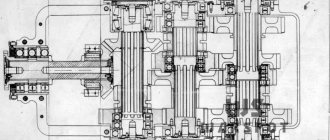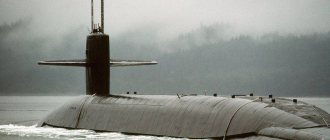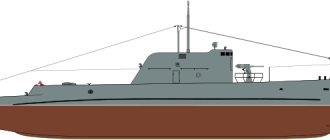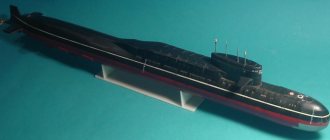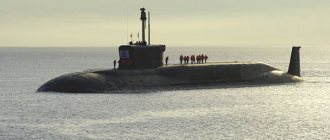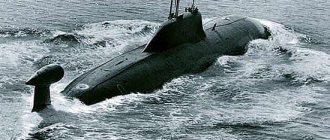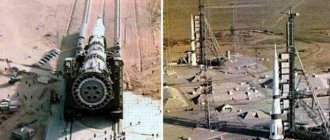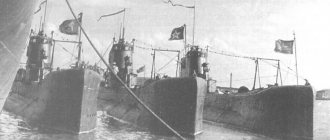The need to create submarines with modern weapons arose in the USSR back in the 50s of the last century. Until this point, the country had produced submarines with diesel-electric engines, the missile systems of which had a short flight range (up to 1,000 km) and low accuracy of hitting the target (about 8 km). Such submarines could only hit large ground targets.
The Coast Guard needed maneuverable high-speed nuclear submarines with modern missile ammunition capable of hitting coastal targets and enemy ships.
Project 659 (NATO - “Echo I”).
Modification – project 659T
Unimplemented modification – 659Р
1. Number of submarines of the project: 5+1
2. Project image:
3. Project composition:
| Ship name | Factory number | Dates | Notes | |||
| bookmarks | descent | entry into service | ||||
| KOMSOMOLSK-ON-AMUR: Lenin Komsomol Plant (No. 199) (5+1) | ||||||
| 1 | K-45 | 140 | 28.12.1958 | 12.05.1960 | 19.11.1960 | 1970 - mod. according to the project 659T 1992? |
| 2 | K-59 | 141 | 30.09.1959 | 25.09.1960 | 16.12.1961 | 1970 - mod. according to the project 659T 07/25/1977 - rename. |
| 3 | K-66 | 142 | 26.03.1960 | 30.07.1961 | 28.12.1961 | 1972 - mod. according to the project 659T 1992? |
| 4 | K-122 | 143 | 21.01.1961 | 17.09.1961 | 06.07.1962 | 1968 - mod. according to the project 659T 1992? |
| 5 | K-151 | 144 | 21.04.1962 | 30.09.1962 | 28.07.1963 | 1976 - mod. according to the project 659T 1992? |
| 6 | K-30 | 145 | — | — | — | 1962 – withdrawn from construction |
| Historical information about the numbered crews of the Project 659 nuclear submarine: 185, 331 | ||||||
4. Project history:
Government decree on the creation of the SSGN project 659
was adopted on August 25 (26), 1956. In September 1956, simultaneously with the start of the development of SSBN
658
, TsKB-18 began developing a technical design for nuclear submarines armed with six P-5 cruise missiles - Project
659
.
The development of both projects was carried out in parallel within the same time frame.
P.P. was appointed
chief designer of project 659. Pustyntsev, his deputy - Nikolai Andreevich Klimov. On October 23, 1956, when a significant part of the project had already been developed, Commander-in-Chief of the Navy S.G. Gorshkov approved the tactical and technical specifications for the development of a nuclear submarine with jet weapons - the P-5 complex, intended to carry out strikes with projectile aircraft on naval bases, ports, industrial and administrative centers located on the coast and inland within reach flight of projectile aircraft. In 1969, after P.P. Pustyntsev became the chief designer of project 675
N.A. was appointed
chief designer of project
659 Klimov, and his deputies - O.Ya. Margolin and V.K. Stankevich. The main observer of the Navy for Project 659
was I.I.
Chufrin and Yu.S. Wolfson.
five submarines were built under Project 659
On October 19, 1957, at a meeting of the Presidium of the CPSU Central Committee, the progress in the construction of the Soviet missile-carrying submarine fleet was considered. A long-term plan for the construction of submarines was approved, according to which by 1961 it was planned to transfer 32 submarines with P-5 cruise missiles to the fleet. Continuation of the construction of carriers of these missiles was planned in the VII Five-Year Plan (1961 - 1965).
By the time the technical design of the boat was completed, there was no technical design for the missile weapons complex. As a result, the technical decisions made on the main weapon were indicative, and all necessary changes were made at the detailed design stage, as well as during construction and even during testing of the lead SSGN.
Construction of submarines project 659
carried out by the plant.
Lenin Komsomol in Komsomolsk-on-Amur (director G.K. Volik). The external contours, based on the conditions for using the jet weapon complex on the surface, were chosen in the same way as on Project 658
. Sharpening the contours of the bow tip made it possible to ensure that the deck was not flooded at speeds up to full surface. Particular attention was paid to finding such contours of the outer hull that, when placing containers with cruise missiles, would not lead to a sharp increase in towing resistance in a submerged position. After considering several options, it was considered most appropriate to raise the superstructure deck to a height equal to the diameter of the missile containers, which ensured that all containers were placed below the superstructure deck.
In the first quarter of 1957, the development of the technical design of the SSGN pr. 659
was completed and the project was submitted for approval, after which, without waiting for approval from high authorities, TsKB-18 began developing a working draft. Despite the difficulties that arose during the development of the detailed design (testing of the P-5 missile system was difficult and dragged on until 1959), the development of drawings was completed in October 1957, which made it possible to build submarines - in September 1958, the first sections of the durable hull were completed were delivered to the slipway (Dock No. 3 of boathouse “A”) and on December 20, 1958 the keel of the lead submarine of the project took place
659
.
Plant named after Leninsky Komsomol was the second in the country to begin the construction of nuclear submarines and largely used the experience of the plant in Severodvinsk, which provided significant assistance in organizing the construction of submarines. On the PLA of the project 659
6 cruise missiles of the P-5 complex were deployed.
The missile was equipped with a nuclear warhead, unified with the warhead of the R-11FM ballistic missile (initially its power was 200 Kt, then increased to 650 Kt). The diameter of the missile body was 1.0 m, length 10.8 m and wingspan 3.7 m. Its launch mass was 5200 km, maximum flight speed corresponded to M = 0.9-1.0, maximum firing range was 350 km. The flight took place at an altitude of 800-900 m. The power plant of the missile launcher included two starting solid fuel boosters and a sustainer turbojet engine KRD-26 (2250 kgf). The control system included an autopilot, a time meter and a barometric altimeter. The missile was transported on a submarine in a sealed container (diameter 1.65 m, length 12 m) filled with nitrogen.
The missile containers were interlocked in pairs into three blocks. Each block of containers was raised to a starting angle of 15° by rotating on a fixed hollow axis, inside which communications were placed connecting the missile and the container with the submarine - electrical to the missile’s onboard connectors, as well as to the means providing the necessary microclimate parameters in the container, and Yar. Before the start, the containers raised to the starting angle were secured with stoppers, and both covers (front and back) were opened. The containers were lifted by hydraulic lifts located in the 2nd, 6th and 7th compartments of the submarine. All containers rose in 140 seconds, lids opened in 20-25 seconds.
A six-missile salvo could be carried out in a certain sequence (6-3-2-5-4-1), where containers 1 and 2 belong to the bow block, 3-4 to the middle block and 5-6 to the stern block.
The cruise missiles were delivered to the submarine in a fully fueled state with the warhead installed and the launch engines attached. The shooting was carried out at a bearing equal to the course of the submarine. The time after the submarine surfaced before the launch of the first missile was about 4 minutes, the preparation time and launch of all 6 cruise missiles was about 12.5 minutes.
Through the open rear cover of the container, exhaust gases entered the gas outlet enclosures located behind the containers. The first design of these enclosures turned out to be unsuccessful - the propulsion engines of the “rear” rockets, when launched, captured the exhaust gases of the “front” rockets and stalled. The geometry of the gas outlet baffles was changed so that the outgoing gas jets were directed away from the launching rocket, which, together with the rocket launch sequence described above, ensured the reliability of the 6-missile salvo.
The submarine had a double-hull architecture. The robust body with a diameter of 6.8 m was divided into nine waterproof compartments. The design ensured surface unsinkability when filling any of the compartments with water.
The ship was equipped with a power plant with a nominal power of 35,000 hp. s., which included two pressurized water reactors VM-A (2x70 mW). There were two groups of batteries with 112 cells each, two creeping electric motors PG-116 (2x450 hp) and two DC diesel generators DG-400. The SSGN was armed with the Pluto-659 navigation system, including the Mayak gyrocompass. There was a hydroacoustic station MG-200 "Arktika", a noise direction finder MG-15, a hydroacoustic radiation detection station MG-13 and other target equipment.
The torpedo armament of the SSGN of the 659th project included four 533-mm bow torpedo tubes (20 SET-65 and 53-61 torpedoes, maximum firing depth - 100 m), as well as four stern torpedo tubes with a caliber of 400 mm (maximum firing depth - 240 m) .
Missile carriers 659
-projects spent their relatively short service in the Pacific Fleet.
Within the range of their missiles were targets on the West Coast of the United States (where, in particular, the largest Boeing aircraft factories in Seattle and other important industrial, military and administrative centers were located), Hawaii, Japan, and the Panama Canal. Probably, Project 659
were also considered as promising ships for arming the young Chinese Navy (however, the cooling of Soviet-Chinese relations in the early 60s interrupted military-technical cooperation between the two great powers for several decades).
The effectiveness of the cruise missiles of the P-5 complex turned out to be low: low firing accuracy, sensitivity of the missiles to the direction and speed of the wind, the impossibility of flying over difficult terrain (with hills and mountains), the dependence of the flight range on air temperature, etc. led to the removal of this missile from service. weapons already in 1966. Attempts to improve the combat qualities of this missile by installing a Doppler path meter and demolishing the missile (P-5D and P-7 complexes) did not give the desired results, which led to the decision to remove missile weapons from submarines of the project 659
.
Since Project 659
did not have modernization capabilities sufficient to re-equip them with anti-ship missiles of the P-6 complex, designed to solve anti-ship tasks (it was necessary to increase the length of the anti-ship missiles, install the Argument complex to adjust the flight path of anti-ship missiles, etc.), a decision was made o re-equipment of boats according to project
659T
(included the removal of all containers, alteration of the superstructure and increase in torpedo armament). The re-equipment of all five submarines was carried out during the period of medium repairs (1968-1976).
It should be noted that the general arrangement of mechanisms, equipment and power plants of submarine projects 658
and
659
was extremely close, despite the difference in the number of compartments.
Many compartments were completely consistent with each other: the fourth compartment of Project 659
was similar to the fifth of Project
658
, the fifth was similar to the sixth, etc.
The degree of intra-project unification of projects 658
,
659
,
675
was extremely high.
Attempts were made to create a project for the 659R
(LPMB "Rubin"). The development project was not received.
In the 90s all nuclear submarines of project 659T
were withdrawn from the fleet and transferred for disposal.
5. Project diagram:
6. Tactical and technical data of the project:
| displacement | ||
| surface normal: | 3730 tons | |
| underwater: | 4920 tons | |
| travel speed | ||
| full underwater under GTZA: | 26 knots | |
| full surface under GTZA: | 15.1 knots | |
| underwater under GED: | 6 knots | |
| surface under DG and GED: | 7 - 8 knots | |
| cruising range (at cruising speed, knots) | ||
| under DG and GED: | 500 miles | |
| immersion depth | ||
| limit: | 300 meters | |
| shipbuilding elements | ||
| length: | 111.2 meters | |
| width: | 9.2 meters | |
| average draft: | 6.35 meters | |
| construction type: | double-hull | |
| weapons | ||
| 400 mm stern torpedo tubes: | 2 | |
| 400 mm bow torpedo tubes: | 2 | |
| 533 mm bow torpedo tubes: | 4 | |
| total number of torpedoes: | 4x400 mm, 12x533 mm | |
| missiles of the P-5 complex: | 6 | |
| type of target designation system: | "North A-659" | |
| power plant | ||
| type: | atomic | |
| PPU type: | VVR VM-A | |
| number x power of reactors, kW: | 2 x 70000 kW | |
| PTU type: | GTZA-601 | |
| quantity x power (on shaft) PTU, hp: | 2 x 17500 hp | |
| quantity x power of TG, kW: | 2 x 1400 (type GPM-21) | |
| quantity x diesel generator power, hp: | 2 x 460 (type PG117) | |
| quantity x power of motor, hp: | 2 x 450 (type PG-116) | |
| number of shafts: | 2 | |
| AB type, number of AB groups x number of elements: | lead-acid 28-CM, 3 x 112 | |
| habitability | ||
| autonomy: | 50 days | |
| crew: | 90 (104?) people | |
7. Sources:
— Kuzin V.P., Nikolsky V.I. “USSR Navy 1945-1991”, IMO, St. Petersburg, 1996. — “Domestic submarines. Design and Construction" under the general editorship of Academician of the Russian Academy of Sciences V.M. Pashin, Central Research Institute named after. acad. A.N. Krylova, St. Petersburg, 2004. - “History of domestic shipbuilding”, vol.V, Shipbuilding, St. Petersburg, 1996. — Shirokorad A.B. “Weapons of the domestic fleet 1945-2000”, Harvest, Ast, Minsk, Moscow, 2001. — Gusev A.N. “Submarines with cruise missiles”, Galeya Print, St. Petersburg, 2000.
Return to the Main page of the site “Assault of the Depths”
Design, selection of material and layout Nikolaev A.S.© 2002-2017
Design description[edit]
According to the project, the estimated weight of the vehicle was 12~13 tons.
Consisted of two people: a driver and a commander-weapon operator. The landing party consisted of 22 people.
Armored hull and turret[edit]
The hull was a welded structure consisting of rolled armor plates, the thickness of which ranged from 16 to 30 mm.
Weapons[edit]
It was planned to use the 2A28 Grom smoothbore 73-mm launcher as the main weapon. The gun's ammunition was supposed to range from 38 to 40 rounds.
Additional armament was a tank version of the 7.62-mm Goryunov machine gun (SGMT), with 2,000 rounds of ammunition.
Engine and transmission[edit]
The engine was to use a ZIL-375 carburetor engine with a power of 140 hp. The engine allowed speeds of up to 85 km/h on wheels and up to 40 km/h on tracks.

